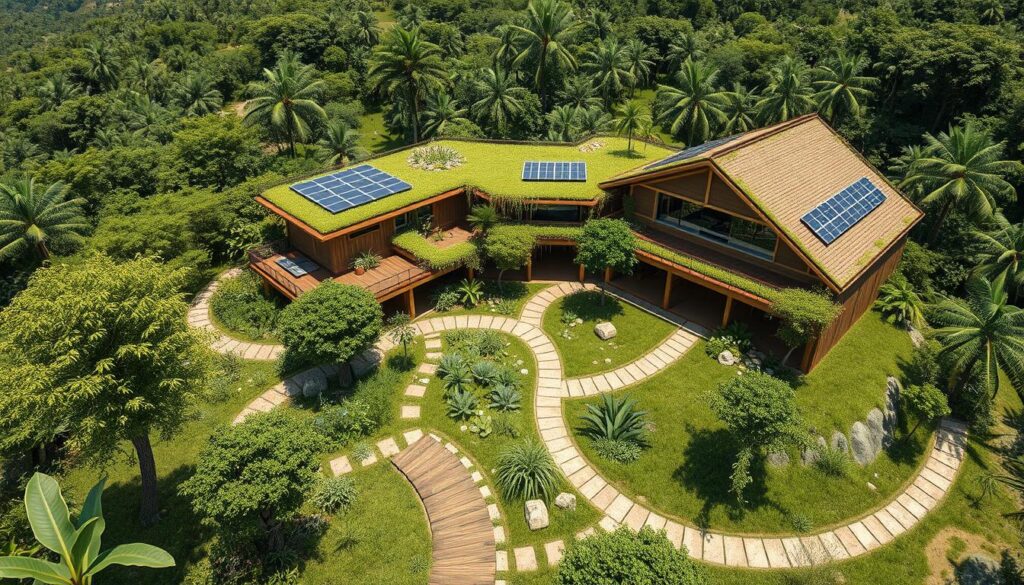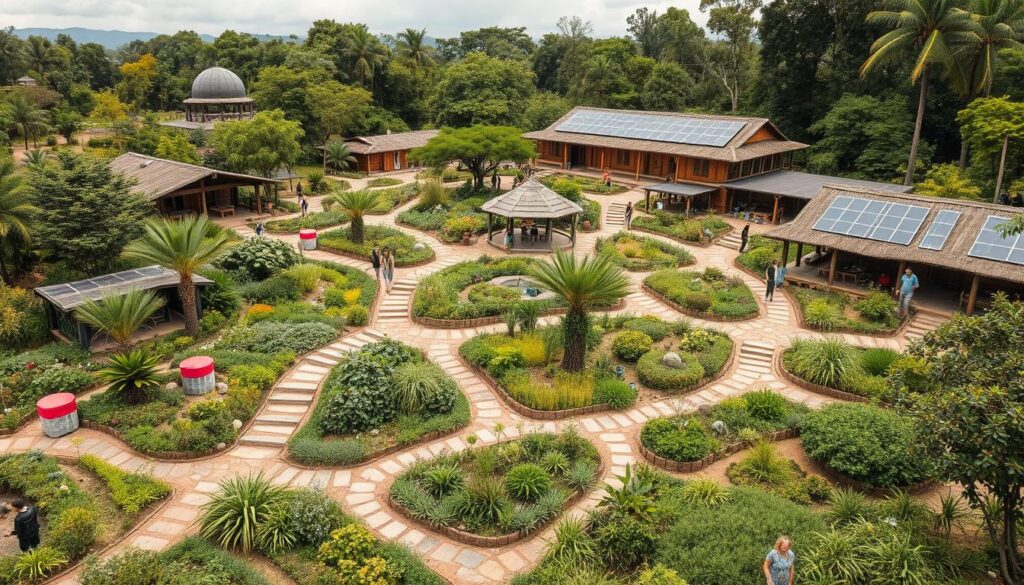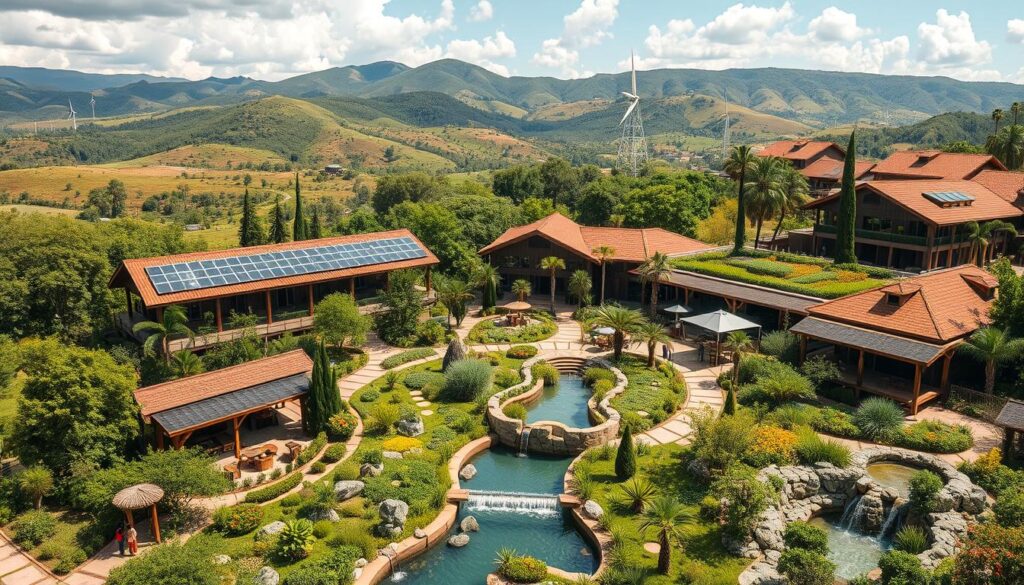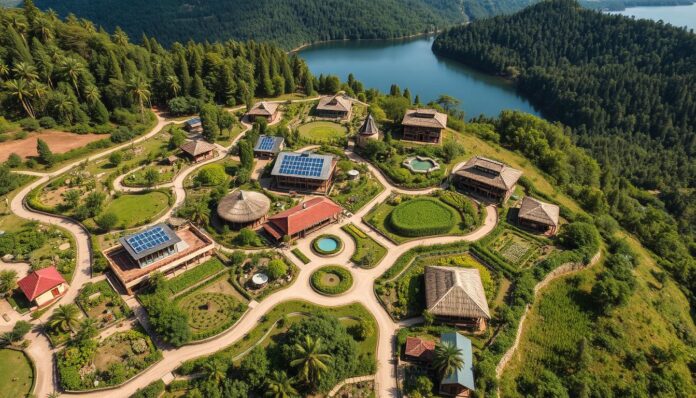The need for sustainable tourism is on the rise. About 73% of travelers now choose places that care for the planet. Creating a sustainable permaculture eco-resort is key. It must have a small environmental impact and offer a special experience for guests. Permaculture resort planning is vital in the hospitality world. It combines sustainable tourism and eco-friendly design.
Using permaculture in resort design helps hotels use less energy and cut carbon emissions. This attracts eco-aware travelers. With the right planning, permaculture eco-resorts can lead the way in green tourism.
Key Takeaways
- Approximately 73% of travelers prefer accommodations that implement sustainability practices, highlighting the importance of permaculture resort planning.
- Permaculture resort planning involves sustainable tourism strategies and eco-friendly hospitality design to minimize environmental footprint.
- Renewable energy sources, such as solar panels, can significantly reduce a resort’s carbon emissions and energy costs.
- Water management systems, including rainwater harvesting and greywater recycling, can reduce overall water consumption by up to 30%.
- Effective master planning can lead to operational efficiency improvements of up to 15% and enhance guest satisfaction ratings.
- The incorporation of eco-friendly materials can reduce a resort’s ecological footprint by 20-40%.
Understanding Permaculture Principles
Permaculture is a way to design sustainable and self-sufficient farms that work like nature. It’s key for eco-tourism, helping hotels and resorts be green. By using permaculture, places can lessen their harm to the environment and work towards a greener future.
The twelve permaculture principles guide many conservation efforts. They show how to observe, plan, and grow in a smart way. Eco-resorts can use these to make their places more sustainable and help the planet.
Key Concepts of Permaculture Design
Permaculture design looks at everything in an ecosystem as connected. It aims to make a system that works on its own, with each part helping others. This way, eco-resorts can become more sustainable and support green tourism.
Benefits of Permaculture for Eco-Resorts
Permaculture brings many good things to eco-resorts. It helps them use less water, waste less, and support more life. By following permaculture, places can become greener and better for guests and the planet.
- Reduced water consumption and waste management
- Increased biodiversity and ecosystem services
- Improved soil health and fertility
- Enhanced guest experience and education
| Permaculture Principle | Benefit for Eco-Resorts |
|---|---|
| Thoughtful observation | Improved ecosystem management and biodiversity |
| Planned redundancy | Increased resilience and self-sufficiency |
| Optimizing yields | Improved resource efficiency and productivity |
Assessing Site Conditions and Resources
When designing an eco-conscious resort, checking the site is key. This means looking at the soil, plants, and water systems. It helps make a place that’s good for the planet and supports sustainable tourism infrastructure.
Checking the soil and plants is important. Soil tests and plant surveys help. This way, resorts can plan to keep the ecosystem healthy. For example, they might use polyculture designs to help the environment.
Evaluating Soil Quality and Biodiversity
Soil and plants are vital for a healthy place. Resorts can find ways to make it better. They might use pioneer plants to start fixing the soil.
Water Management Solutions
Water use is also important. Resorts can save water with smart systems. They might use rainwater and greywater to cut down on waste.
Climate Considerations for Sustainable Design
Climate matters a lot for green design. Resorts can pick plants that fit the local weather. This makes the place strong and supports sustainable tourism infrastructure.
Integrating Community Involvement in Planning
Planning environmentally friendly resorts is key for success. It supports sustainable tourism. Community involvement is vital, ensuring the resort meets local needs and values. By working with locals and organizations, planning becomes a team effort that benefits everyone.
Community-supported initiatives are great for sustainable tourism. For example, community-supported agriculture (CSA) helps the resort get fresh produce. It also helps local farmers, boosting the local economy.
Here are some ways to involve the community in planning:
- Hold public meetings and workshops to get feedback and ideas.
- Partner with local organizations to support community projects.
- Use community-supported agriculture to promote local food systems.
By using these strategies, permaculture resorts can positively impact their communities. They support sustainable tourism and environmentally friendly planning. This leads to a more sustainable tourism model, where both the resort and community thrive.
Designing Sustainable Infrastructure
In green hotel planning, looks and environment matter. Eco-friendly design is key for regenerative tourism development. It aims to reduce harm to nature and support sustainability.
Using eco-friendly building materials is a big part of this. These materials come from local sources, cutting down on emissions. They’re also recyclable, which helps avoid waste. Plus, renewable energy options like solar and wind power can greatly lower a hotel’s carbon footprint.
Eco-Friendly Building Materials
Materials like reclaimed wood, low-VOC paints, and sustainable floors are used. They lessen environmental harm and make a healthier space for guests.
Rewable Energy Options
Renewable energy is gaining ground in hotels. Solar panels and wind turbines can power hotels, lessening their need for fossil fuels.
Waste Management Strategies
Good waste management is vital for a hotel’s green efforts. Recycling, composting food waste, and saving water are all effective ways to cut down on waste.

By using these methods in green hotel planning and eco-friendly hospitality design, hotels can help regenerative tourism development. They can also lessen their environmental impact.
| Strategy | Benefits |
|---|---|
| Eco-friendly building materials | Reduced waste, healthier environment |
| Renewable energy options | Reduced carbon footprint, lower energy costs |
| Waste management strategies | Reduced waste, conserved resources |
Creating Functional Zones in the Resort
Designing an eco-resort means creating zones for different needs. This includes areas for living, farming, and fun. Sustainable landscape architecture is key here. It makes the resort look good and helps the planet.
Using organic permaculture practices lets resorts grow their own food. This makes them less dependent on outside help. It’s good for the planet and gives guests a special experience. Some important parts of an eco-resort include:
- Agricultural zones for food production
- Recreational spaces, such as parks and gardens
- Residential and guest areas, designed with eco-conscious resort design principles in mind
Resorts that follow these ideas create a better world for everyone. As more people want green places to visit, using sustainable landscape architecture, organic permaculture practices, and eco-conscious resort design is crucial.
| Zone Type | Description |
|---|---|
| Agricultural Zones | Areas for food production, using organic permaculture practices |
| Recreational Spaces | Parks, gardens, and other areas for guest relaxation and enjoyment |
| Residential and Guest Areas | Designed with eco-conscious resort design principles, minimizing environmental impact |
Establishing Educational Programs and Workshops
Creating educational programs and workshops is key in permaculture resort planning. It helps spread the word about living sustainably. These programs teach about green resort planning and building sustainable tourism.
They focus on the value of biodiversity, strong ecosystems, and community ties. This education is vital for a better future.
Working with experts and local artists makes learning more engaging. They offer hands-on lessons on composting, saving rainwater, and supporting local farms. This approach helps resorts become greener and support local areas.

- Curriculum development focused on sustainability and permaculture principles
- Collaborations with experts and local artists to provide diverse perspectives
- Practical workshops on sustainable practices, such as composting and rainwater harvesting
- Emphasis on community involvement and sustainable tourism infrastructure
Through these programs, permaculture resorts can lead the way in sustainability. They help local communities and support green resort planning and tourism.
Marketing Eco-Resorts as Sustainable Destinations
Eco-resorts need good marketing to attract green travelers. They should focus on eco-friendly design, regenerative tourism, and green planning. This way, they can stand out and win over customers.
Marketing strategies include a unique selling point, digital marketing, and showing off sustainability. For instance, a resort might talk about using solar power and saving water.
Eco-resorts can also use social media and influencers to get more people to know about them. Working with influencers and eco-experts helps show off their green efforts. This attracts travelers who care about the planet.
| Marketing Strategy | Description |
|---|---|
| Unique Value Proposition | Emphasize the resort’s commitment to sustainability and eco-friendly practices |
| Digital Marketing | Utilize social media, email marketing, and online advertising to reach a wider audience |
| Influencer Marketing | Partner with social media influencers and eco-tourism experts to showcase the resort’s sustainable practices |
By using these marketing tactics, eco-resorts can meet the growing need for green travel. They can become leaders in the industry by focusing on eco-friendly design and green planning.
Financial Planning for Permaculture Resorts
Financial planning is key when setting up a permaculture resort. Using sustainable tourism and eco-friendly planning can make a big difference. It helps make the resort financially stable. By applying permaculture principles, costs can go down, and new ways to make money can be found.
Important steps include making a budget for the start, looking for funding, and figuring out ongoing costs. Using permaculture gardens and energy-saving upgrades can cut down on expenses. Also, sharing eco-friendly efforts on social media can draw in guests who care about the planet.

By mixing sustainable tourism and permaculture into financial planning, eco-resorts can build a solid financial base. This also helps them stand out in a crowded market. It attracts guests seeking unique, green experiences.
Key Financial Considerations
- Budgeting for initial investments in sustainable infrastructure
- Seeking funding and grants for permaculture projects
- Estimating long-term operational costs and revenue streams
By thinking about these points and using sustainable tourism and permaculture in planning, eco-resorts can thrive. They can do well financially while also protecting the environment.
Monitoring and Evaluating Eco-Resort Performance
To make sure eco-resorts are truly green, it’s key to check their performance often. We track things like energy use, water use, and how they handle waste. Eco-conscious resort design is vital here, using organic permaculture practices and sustainable tourism infrastructure to cut down on harm to the environment.
A good system for checking how eco-resorts do helps them find ways to get better. They might add sustainable tourism infrastructure like green energy and eco-friendly travel options. With eco-conscious resort design and organic permaculture practices, they can use less of the earth’s resources. This makes the place better for both visitors and the local area.
Some important things to keep an eye on include:
- Energy use and carbon emissions
- Water use and saving efforts
- How they handle waste and recycling
- What guests think and say
By checking their performance often, eco-resorts can spot chances to get better. They can make smart choices based on facts to be greener and lessen their impact. This is good for the planet and helps the resort do well for a long time.
| Metric | Target | Current Performance |
|---|---|---|
| Energy consumption | Reduce by 20% | 15% reduction achieved |
| Water usage | Conserve 30% | 25% conservation achieved |
| Waste management | Recycle 80% | 75% recycling rate achieved |
Networking with Other Permaculture Operators
Regenerative tourism is becoming more popular in the hospitality world. Many eco-resorts are now focusing on green hotel planning and eco-friendly design. By connecting with other permaculture experts, these resorts can learn and grow together.
Being part of collaborations offers many benefits. You get access to valuable knowledge and resources. For instance, the Permaculture Design Course (PDC) provides online learning with practical exercises and Q&A sessions. This is great for those wanting to boost their sustainability efforts.
Attending permaculture conferences is another excellent way to meet others and learn new things. These events bring together industry experts and offer chances for networking and teamwork.

Conferences highlight the need for community, biodiversity, and sustainable land use. By adopting these principles, eco-resorts can lessen their environmental footprint. They also improve the guest experience.
| Conference | Location | Date |
|---|---|---|
| Permaculture Conference | New York | 2024 |
| Regenerative Tourism Summit | California | 2025 |
Legal and Regulatory Considerations
When starting a permaculture resort, it’s key to look at the legal and regulatory side. This includes zoning laws and land use policies. These can shape the resort’s design and how it runs. Sustainable tourism strategies must be part of the planning to follow the rules.
It’s also important to follow environmental regulations. Permaculture resorts aim to be environmentally friendly. They use renewable energy and cut down on waste. Permaculture resort planning focuses on being green and caring for the environment.
To meet the rules, resort developers should:
- Do deep research on local zoning laws and land use policies
- Work with environmental experts to create sustainable tourism plans
- Use green practices, like using less energy and waste
By focusing on legal and regulatory aspects, permaculture resorts can thrive. They help protect the environment. This benefits the resort and the local community, making a positive impact on both the environment and the economy.
Innovations in Permaculture Resort Design
Permaculture resort design is getting a boost from new tech and green practices. This is making eco-resorts more appealing to travelers. They want places that offer a special experience and help the planet.
Designers are focusing on making eco-resorts that look great and are good for the environment. They use natural materials and systems. This makes the resorts both beautiful and useful. Renewable energy, like solar and wind, is key to making these resorts energy-neutral.
Incorporating Technology in Sustainability Efforts
Technology is helping make eco-resorts more sustainable. For instance, energy-saving systems and smart water use are being used. New materials and designs are also being explored for building and infrastructure.
Case Studies of Successful Eco-Resorts
Many eco-resorts have successfully applied permaculture and green practices. The Permaculture Design Company, for example, has worked in Eastern Africa. They’ve built a project called Fumba Town Residential, which will house 15,000 people sustainably.
They’ve also created a system to make fertile soil from organic materials. This shows how permaculture can lead to innovation and sustainability in eco-resorts.
| Project | Location | Sustainable Features |
|---|---|---|
| Fumba Town Residential development | Eastern Africa | Sustainable homes, soil-creation system |
| Aqua Beach Lodge | Eastern Africa | Renewable energy systems, sustainable water management |
These examples highlight the potential of permaculture in eco-resort design. By using eco-friendly design, regenerative tourism, and sustainable landscapes, eco-resorts can offer unique experiences. They also help the environment and support local communities.
Future Trends in Permaculture Resort Planning
Permaculture resorts are becoming more important as people want to travel sustainably. These resorts will need to focus on sustainable tourism infrastructure, environmentally friendly resort planning, and new permaculture resort planning ideas. This is to meet the growing need for experiences that connect with nature.
Travelers will look for resorts that use renewable energy, save water, and manage waste well. Resorts that grow their own food, engage with local communities, and protect biodiversity will stand out. This is a great chance for permaculture resorts to lead in the sustainable travel field.

